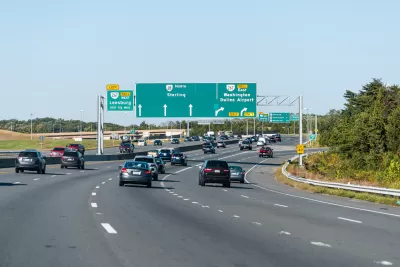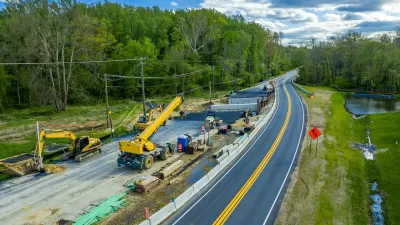The Northern Virginia Transportation Authority’s plans to widen and expand the region’s highways will lead to a sharp increase in vehicle miles driven, a new study shows.

An analysis of the Northern Virginia Transportation Authority’s long-range plans predicts an increase in driving thanks to the agency’s road expansion plans. “Instead of helping Northern Virginians drive less, the proposed 1,200 miles of new pavement would make the region more car-dependent,” Bill Pugh reports, citing results from a study by the Coalition for Smarter Growth (CSG).
CSG’s On the Wrong Road report analyzed the current TransAction plan and found that Loudoun County would expand its arterial highways at a rate of 1.5 times its population growth and Prince William County at a rate of three times faster than its population growth. Fairfax and Manassas would also build arterial highway miles faster than their population growth.
Pugh cites research showing the “well-documented phenomenon of induced demand,” writing that “CSG used the State Highway Induced Frequency of Travel calculator, developed by Rocky Mountain Institute, and found that the TransAction plans could make Northern Virginia residents and workers drive almost 3 billion more miles per year by 2040 on top of new car trips anticipated from population and job growth.”
Some examples from the analysis: Loudon’s highway network could see a rise of 42 percent in vehicle miles traveled (VMT), while Price William’s non-interstate highway VMT could increase by 60 percent.
“New and expanded highway projects also spark more spread out and auto-dependent development, which generate even more driving and traffic over time,” Pugh writes. “This increased car dependence would also make it impossible for Northern Virginia to meet its climate commitments.” The CSG is calling on the NVTA to take steps to evaluate the potential for induced demand, support more sustainable transit modes, and “adopt a plan that will foster more walkable, transit-oriented communities with a range of housing options.”
FULL STORY: Northern Virginia highway plans would fuel a massive increase in driving

Alabama: Trump Terminates Settlements for Black Communities Harmed By Raw Sewage
Trump deemed the landmark civil rights agreement “illegal DEI and environmental justice policy.”

Planetizen Federal Action Tracker
A weekly monitor of how Trump’s orders and actions are impacting planners and planning in America.

Why Should We Subsidize Public Transportation?
Many public transit agencies face financial stress due to rising costs, declining fare revenue, and declining subsidies. Transit advocates must provide a strong business case for increasing public transit funding.

Understanding Road Diets
An explainer from Momentum highlights the advantages of reducing vehicle lanes in favor of more bike, transit, and pedestrian infrastructure.

New California Law Regulates Warehouse Pollution
A new law tightens building and emissions regulations for large distribution warehouses to mitigate air pollution and traffic in surrounding communities.

Phoenix Announces Opening Date for Light Rail Extension
The South Central extension will connect South Phoenix to downtown and other major hubs starting on June 7.
Urban Design for Planners 1: Software Tools
This six-course series explores essential urban design concepts using open source software and equips planners with the tools they need to participate fully in the urban design process.
Planning for Universal Design
Learn the tools for implementing Universal Design in planning regulations.
Caltrans
Smith Gee Studio
Institute for Housing and Urban Development Studies (IHS)
City of Grandview
Harvard GSD Executive Education
Toledo-Lucas County Plan Commissions
Salt Lake City
NYU Wagner Graduate School of Public Service





























